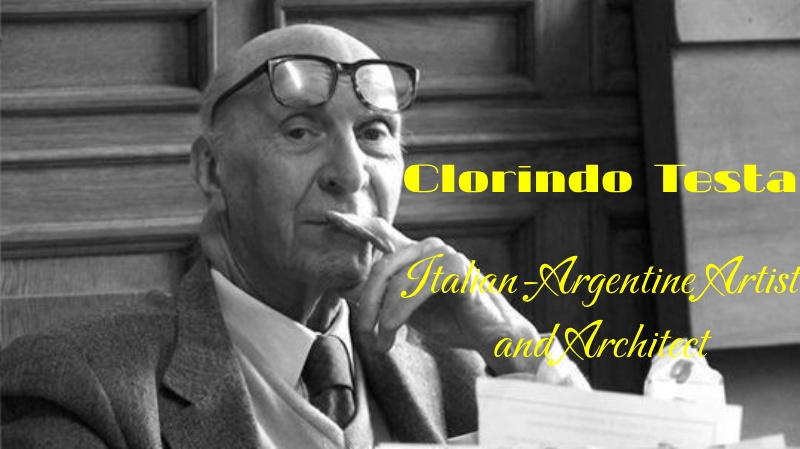Festivals & Events
Interesting Facts about Clorindo Testa, an Italian-Argentine Architect and Artist

The fanciful Clorindo Testa is a mainstay of modern Argentine architecture, having architect the Bank of London in Buenos Aires as well as the National Library of the Argentine Republic.
Today’s Google Doodle honors Clorindo Testa, an Italian-Argentine architect and artist who is regarded as one of the key figures in Latin American modern architecture. The most prominent prize for visual arts in Argentina, the Konex Award, was given three times to Clorindo Manuel José Testa, a key player in the Brutalist architectural movement in Latin America. One of Testa’s most famous creations, the Mariano Moreno National Library of Argentina, was designated a national historic monument on November 27, 2019.

Who was Clorindo Testa?
Throughout his five-decade career, Clorindo Testa has made a lasting impression on Argentine architecture. A key player in the development of brutalism and one of the most significant figures in Latin American modernism, Testa showed a natural talent for painting from an early age, which influenced his unique approach to architectural practice. His distinctive style and urban sensibility immediately distinguished him as a free-spirited alternative to Mario Roberto Álvarez’s more meticulous and academic style, which is the other titan of modern Argentine architecture.
Quick Look
- Birth date: December 10, 1923
- Birthplace: Benevento, Italy
- Died on: April 11, 2013 (aged 89)
- Death place: Buenos Aires, Argentina
- Nationality: Italian-Argentine
- Famous as: Architect
- Buildings:
- Banco de Londres y América del Sur
- Biblioteca Nacional de la República Argentina
- La Perla Spa
40 Interesting Facts about Clorindo Testa
- His parents were Italian, and Clorindo Testa was born on December 10, 1923, in Benevento, near Naples, Italy. Later that year, he studied electromechanical engineering for a short while before being admitted to the public University of Buenos Aires to study architecture.
- He fell in love with art at a young age after his family relocated to Argentina when he was a young child. In 1948, he received his architecture degree from the Universidad de Buenos Aires Faculty of Architecture.
- After completing his studies in 1948, at the end of the Argentine Rationalist movement, he was among the first graduates of the newly established School of Architecture and Urban Planning.
- Testa first studied naval engineering before turning to civil engineering for architecture. Following a two-year stay in Europe, he also excelled as a painter.
- Clorindo Testa first became a member of Grupo Austral, a group of up-and-coming architects started by Juan Kurchan, Antonio Bonet, and Jorge Ferrari Hardoy.
- Testa won a competition to construct the Argentine Chamber of Construction upon his return three years later, after which he joined the studio of Francisco Rossi, David Gaido, and Boris Dabinovic. In 1949, Testa was awarded a university scholarship to study in Europe.
- Located over 600 kilometers from the capital in Santa Rosa, rural La Pampa province, his first large-scale project also remains relatively unknown.
- In 1955, the construction of a government center in La Pampa was his first major project. His official introduction to brutalist architecture, which features simple structures that highlight raw building materials rather than decorative designs, came with this project.
- He was the winner of a competition in 1955 to construct an ambitious nine-hectare campus that included the Civic Center, which housed government offices, and a bus terminal. Sessions Chamber followed in 1976, and the city library known as “the Armadillo” opened its doors in 2004.
- After designing the Banco de Londres y América del Sud (Bank of London and South America), which is today regarded as a masterwork of Brutalist architecture, Testa would achieve international recognition four years later.
- Clorindo Testa was then hired in 1962 to complete the Biblioteca Nacional de la República Argentina, also known as the National Library of the Argentine Republic. His standing as a leading architect was solidified by these two projects on a national and international scale.
- Testa worked on his two most famous and monumental projects between 1959 and 1962. In 1959, he won a private competition for the Bank of London, and three years later, he won the state-funded National Library.
- Both would solidify his reputation locally and propel him into the global arena. Both were also joint ventures, first with the esteemed SEPRA studio (Sanchez Elia, Peralta Ramos, and Agostini) and then with Alicia Cazzaniga and Francisco Bullrich.
- Collaborating with more experienced architects turned out to be a productive and essential counterbalance, enabling Testa to channel his inventiveness and put his more fantastical concepts into reality.
- Testa defied established typological norms of planning and organization by forsaking formal and functional precedents in favor of experimenting with volume and space in a startlingly unconventional manner for both the bank and the library.
- He rejected the traditional box construction for the Bank of London, which had an even distribution of beams and columns. In its place, he designed a large entrance hall with two exposed concrete pillars that served as stairs and support for the upper levels.
- Testa suggested reorganizing the National Library, under the direction of Jorge Luis Borges at the time, to better reflect the library’s significance in Argentine intellectual and cultural life. Despite being approved in 1962, the project didn’t open to the public until 1992.
- Clorindo Testa approached problem-solving by rethinking and rephrasing, “as if there hadn’t been hundreds of precedents for the case in question,” as noted by Argentine architectural critic Marina Waisman.
- By doing this, he was able to take advantage of his ability to experiment with the visual, which was based on the lively informality of his painting style, and apply it to architecture during an era in Argentina when everything seemed possible.
- Torcello talks about Testa’s colorful, flowing, and very unusual method of weaving and embroidering his creations on paper in an effort to win competitions. He has always been attracted to nautical references, drawing and painting boats since he was a young child.
- His 1970 victory in the Naval Hospital competition was based on the idea of a building presented after an anchored ship, complete with blue glass tiles and porthole-style windows.
- Absorbing himself in his own musings and his daily painting routine, Clorindo Testa was rarely forthcoming in citing influences beyond a brief allusion to Le Corbusier.
- The peculiarities of the regional dialect are far more inspired by him than events occurring overseas. He compared Argentina to India and found Buenos Aires’ chaotic character to be fascinating.
- His studio was on the sixth floor of a French Neoclassical building designed by the same architects as the city’s Teatro Colón, but what he saw on a daily basis was anything but set-piece grandeur, consisting of a disorganized display of retail establishments, 1960s apartment buildings, and decaying rooftops strewn with detritus.
- Across from his balcony was a medianera, an ordinary party wall broken up over time by haphazardly placed, ill-planned windows of various sizes and shapes, and other impromptu additions made by the occupants.
- In the later years of his career, Clorindo Testa frequently sketched and described this imperfect and characteristically Buenos Aires tableau in lectures to college classes.
- Juan Fontana, an architect and artist who was Testa’s former associate and collaborator until his death in 2013, likens showing up at the studio to a child going to play with his friends.
- Buenos Aires Design (1990–1993), a mall in the upscale Recoleta neighborhood of the city, and the Notary Public School (1999) are two notable examples.
- Clorindo Testa’s late-career persona as an octogenarian in a suit and bespectacles contrasted with his stylistic versatility and youthful playfulness. Though he was always approachable to his students or anyone seeking advice, he enjoyed spending hours alone in quiet contemplation at his desk in his studio or in the restaurant of the Central Society of Architects.
- A well-known private commission he completed was designing a private home for the art collector Guido Di Tella and his spouse. With complete freedom to experiment, Testa added ramps, slopes, and polished concrete, just as he had done with the National Library and the Bank of London.
- The result is a reimagining of the classic Argentine casa chorizo, a one-story home set around a courtyard with a somber facade that revealed little to the street. The house failed to obtain patrimonial status and was demolished in 2011.
- Clorindo Testa was one of the founders of the brutalist movement in Argentina as well as one of the leaders of the country’s nationalist movement.
- His artistic background has always informed his architectural style, which is typified by his use of color, tension, metaphors, and plasticity. His designs for the Banco de Londres building in Buenos Aires and the Biblioteca Nacional de la República Argentina are excellent examples of these elements.
- He was a member of the international jury that selected Carlos Ott to design the Paris Opera Bastille.
- In 1982, 1992, and 2012, Testa was the recipient of the Konex Award, the most esteemed honor in Argentina for visual arts.
- Clorindo Testa died in Buenos Aires, Argentina, on April 11, 2013, at the age of 89.
- By challenging the conventions and limitations of 20th-century buildings, Testa contributed to the creation of a new architectural language and style in Argentina.
- Clorindo Testa completed over 60 projects during his career and was the recipient of three Konex Awards (1982, 1992, and 2012).
- A renowned modern architect, Testa was a highly regarded artist who left his mark brick by brick.
- Google celebrated Clorindo Testa on November 27, 2023, by showcasing a Google Doodle on its homepage.
-

 Gadget4 weeks ago
Gadget4 weeks agoAfter Grand Success on BLDC Ceiling Fan, Eff4 Is Launching Smart Bulb
-

 Festivals & Events4 weeks ago
Festivals & Events4 weeks agoGoogle Celebrates Cherry Blossom Season with Animated Doodle
-

 Business3 weeks ago
Business3 weeks agoPrakash and Kamal Hinduja: Driving Social and Environmental Change
-
Education3 weeks ago
Fred DuVal: University Leadership as a Critical Resource for Climate Change Research and Life-Saving Solutions
-

 Health3 weeks ago
Health3 weeks agoThe Hinduja Brothers Commitment to Global Health: Empowering Communities Across Borders
-

 Cryptocurrency3 weeks ago
Cryptocurrency3 weeks agoDesigned For The Masses: How Akasha (AK1111) Is Unlocking Crypto For The Next Billion Users
-

 Cryptocurrency3 weeks ago
Cryptocurrency3 weeks agoNexaglobal & Future World Token (FWT): Could This Be the Next Big Crypto Investment of 2025?
-

 Sports4 weeks ago
Sports4 weeks agoWomen’s NCAA Tournament 2025 Sweet 16: Full Schedule, Fixtures, Teams, Bracket, and How to Watch March Madness Basketball Match Live























